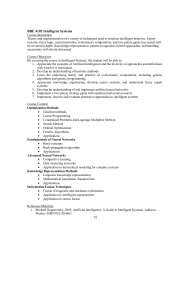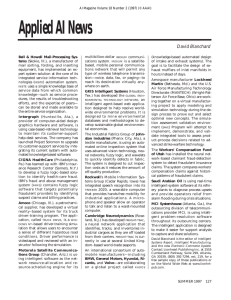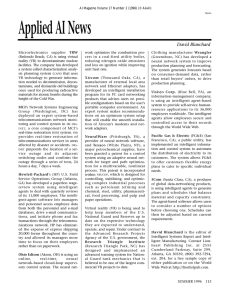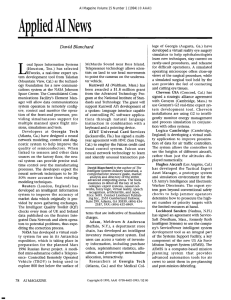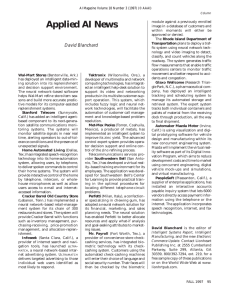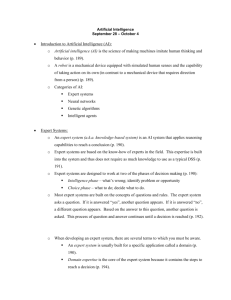Intelligent distributed simulation and control of power plants
advertisement
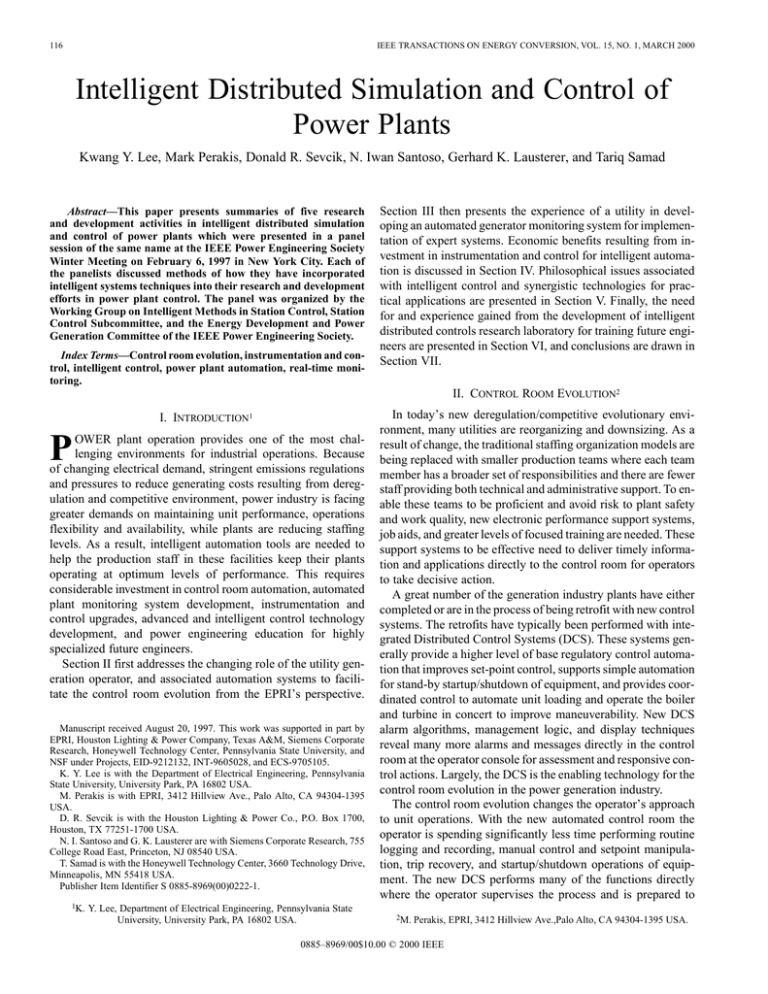
116 IEEE TRANSACTIONS ON ENERGY CONVERSION, VOL. 15, NO. 1, MARCH 2000 Intelligent Distributed Simulation and Control of Power Plants Kwang Y. Lee, Mark Perakis, Donald R. Sevcik, N. Iwan Santoso, Gerhard K. Lausterer, and Tariq Samad Abstract—This paper presents summaries of five research and development activities in intelligent distributed simulation and control of power plants which were presented in a panel session of the same name at the IEEE Power Engineering Society Winter Meeting on February 6, 1997 in New York City. Each of the panelists discussed methods of how they have incorporated intelligent systems techniques into their research and development efforts in power plant control. The panel was organized by the Working Group on Intelligent Methods in Station Control, Station Control Subcommittee, and the Energy Development and Power Generation Committee of the IEEE Power Engineering Society. Index Terms—Control room evolution, instrumentation and control, intelligent control, power plant automation, real-time monitoring. Section III then presents the experience of a utility in developing an automated generator monitoring system for implementation of expert systems. Economic benefits resulting from investment in instrumentation and control for intelligent automation is discussed in Section IV. Philosophical issues associated with intelligent control and synergistic technologies for practical applications are presented in Section V. Finally, the need for and experience gained from the development of intelligent distributed controls research laboratory for training future engineers are presented in Section VI, and conclusions are drawn in Section VII. II. CONTROL ROOM EVOLUTION2 I. INTRODUCTION1 P OWER plant operation provides one of the most challenging environments for industrial operations. Because of changing electrical demand, stringent emissions regulations and pressures to reduce generating costs resulting from deregulation and competitive environment, power industry is facing greater demands on maintaining unit performance, operations flexibility and availability, while plants are reducing staffing levels. As a result, intelligent automation tools are needed to help the production staff in these facilities keep their plants operating at optimum levels of performance. This requires considerable investment in control room automation, automated plant monitoring system development, instrumentation and control upgrades, advanced and intelligent control technology development, and power engineering education for highly specialized future engineers. Section II first addresses the changing role of the utility generation operator, and associated automation systems to facilitate the control room evolution from the EPRI’s perspective. Manuscript received August 20, 1997. This work was supported in part by EPRI, Houston Lighting & Power Company, Texas A&M, Siemens Corporate Research, Honeywell Technology Center, Pennsylvania State University, and NSF under Projects, EID-9212132, INT-9605028, and ECS-9705105. K. Y. Lee is with the Department of Electrical Engineering, Pennsylvania State University, University Park, PA 16802 USA. M. Perakis is with EPRI, 3412 Hillview Ave., Palo Alto, CA 94304-1395 USA. D. R. Sevcik is with the Houston Lighting & Power Co., P.O. Box 1700, Houston, TX 77251-1700 USA. N. I. Santoso and G. K. Lausterer are with Siemens Corporate Research, 755 College Road East, Princeton, NJ 08540 USA. T. Samad is with the Honeywell Technology Center, 3660 Technology Drive, Minneapolis, MN 55418 USA. Publisher Item Identifier S 0885-8969(00)0222-1. 1K. Y. Lee, Department of Electrical Engineering, Pennsylvania State University, University Park, PA 16802 USA. In today’s new deregulation/competitive evolutionary environment, many utilities are reorganizing and downsizing. As a result of change, the traditional staffing organization models are being replaced with smaller production teams where each team member has a broader set of responsibilities and there are fewer staff providing both technical and administrative support. To enable these teams to be proficient and avoid risk to plant safety and work quality, new electronic performance support systems, job aids, and greater levels of focused training are needed. These support systems to be effective need to deliver timely information and applications directly to the control room for operators to take decisive action. A great number of the generation industry plants have either completed or are in the process of being retrofit with new control systems. The retrofits have typically been performed with integrated Distributed Control Systems (DCS). These systems generally provide a higher level of base regulatory control automation that improves set-point control, supports simple automation for stand-by startup/shutdown of equipment, and provides coordinated control to automate unit loading and operate the boiler and turbine in concert to improve maneuverability. New DCS alarm algorithms, management logic, and display techniques reveal many more alarms and messages directly in the control room at the operator console for assessment and responsive control actions. Largely, the DCS is the enabling technology for the control room evolution in the power generation industry. The control room evolution changes the operator’s approach to unit operations. With the new automated control room the operator is spending significantly less time performing routine logging and recording, manual control and setpoint manipulation, trip recovery, and startup/shutdown operations of equipment. The new DCS performs many of the functions directly where the operator supervises the process and is prepared to 2M. Perakis, EPRI, 3412 Hillview Ave.,Palo Alto, CA 94304-1395 USA. 0885–8969/00$10.00 © 2000 IEEE LEE et al.: INTELLIGENT DISTRIBUTED SIMULATION AND CONTROL OF POWER PLANTS take manual control if a significant problem is detected. As a result of automation from the DCS control retrofits the operator now has the time for problem resolution, process management, performance evaluation and optimization, and emissions control and management. To facilitate these higher order process management responsibilities, the operator needs additional automation tools and access to information systems to enable proficient process management. A. Plant Information Management At the core of a control room automation is a plant information management system (PIMS). The DCS now makes available to the operator copious amounts of “data,” that can be overwhelming when considered as real-time process data, alarms, messages, shift logs, events logs and compiled calculations, and the multiplicity function of archived data. Advances in PIMS technologies automates the process of compiling the information into applications to present “Knowledge” to the production staff for evaluation. Information embedded in the PIMS system has been accessed for a number of expert system applications associated with control room automation. These expert systems continuously monitor and evaluate the process and provide results to augment the knowledge of the production staff or provide direction in the form of messages, alerts, and operational procedures, e.g., Cycle Chemistry Expert and Heat Rate Expert. Mathematical regression techniques and neural networks are being applied to use available process data and artificially compute the parametric values needed by the advanced automation applications, such as a backup to emissions monitors or key heat rate parameters. B. Plant Automation Structure As units are being transitioned from base loaded to cycled operations, utilities are applying automated startup applications to ensure consistent startups, minimizing wear and tear on major equipment, reducing start-up time and enhancing operator performance to reduce the number of staff needed for start-up. At the lowest level of the automation structure are the base regulatory controls integrating discrete start/stop and analog functions for individual components in the controller nodes of the DCS. The next three levels provide automation logic that are typically located in a supervisory controller node of the DCS. First is startup logic for equipment; operators can intercede and provide single button start-up of equipment. Second is Systems level logic enabling parallel startup operations of major process systems. Finally, the Plant level logic, where the operator has control to initiate, hold and resume plant automated startup. C. Advanced Automated Control Significant advancements in new algorithms and control strategies have been made by the DCS for “base regulatory” controls which has improved plant performance, reduced transient operation of highly maneuverable units and improved unit availability. To obtain even greater benefit and cost savings, three additional levels of automated control are being applied. Internal in the DCS, utilities are applying the next level, “supervisory control,” integrated with the base regulatory controls. 117 The supervisory controls evaluate process operations, optimize the highly interactive multivariable nature of boiler operations, and provide indexed set-points for individual drives. One application being demonstrated is the use of neural networks to model the combustion process, and optimize the opposing relationship between NOx emissions constraints and efficient boiler performance. The intelligent supervisory sootblower controller is another application of advanced control being demonstrated. Neural network algorithms are being used to model ash deposition and predict growth in different locations of the boiler, mathematical regression techniques optimizes the one hundred or so variables based on cost, and develops an optimum schedule for supervisory control of it’s operations. Work is presently underway to improve the dispatch operations between the energy management system and generating unit as the next level of control automation. A direct digital link based on utility TCP/IP standards are being demonstrated to provide common communications between the EMS and a variety of DCS’s. The EMS digital communications can interface with the unit coordinated controllers to index load setpoints and ramp rates for more accurate and responsive generation. The highest level control automation is “Supervisory Generation Asset Management.” This system optimizes the cost of generation and control of emissions throughout all generation assets to develop individual unit dispatch requirements. This controller will establish predictive load demands, establish load trajectories, select modes of operation between variable and constant pressure, and dispatch the units for least cost. III. REALTIME GENERATOR MONITORING3 This presentation describes the design of a prototype system for automated generator monitoring at Houston Lighting & Power Company (HL&P). The idea for this system came from the automated substation monitoring and analysis system utilizing a high performance data acquisition front-end digital fault recorder (DFR) and data processing using an expert system [2], [3]. This substation system has been operational for over two years. The generator system was retrofitted in 1996 on a coal fueled 730 MW generator unit (originally constructed in the mid 1970’s) and is currently under initial operations monitoring. This new system benefits several groups responsible for generator system operation: 1. A high performance system capable of making intelligent conclusions based on a variety of system measurements may simplify the operator tasks while improving the overall quality of the operation of the unit. 2. A system capable of recording generator operating conditions with increased accuracy and selectivity may provide useful information for analysis of the generator operating performance and improvements in engineering design practices. 3. Access to data, describing abnormal operations and conditions on the generator may improve protection engineers’ and maintenance technicians’ capability to 3D. R. Sevcik, Houston Lighting & Power Co., P.O. Box 1700, Houston, TX 77251-1700 USA. 118 IEEE TRANSACTIONS ON ENERGY CONVERSION, VOL. 15, NO. 1, MARCH 2000 troubleshoot various operations of control and protective relaying systems and to better understand impact of these systems on the generator. A. System Implementation A digital fault recorder serves as the data acquisition front-end, providing a continuous data flow to the monitoring system PC while maintaining its basic function of recording the events according to internal triggers, storing these events on the local hard drive and making these events available remotely over a dial-up line. The DFR system consists of a total of 64 analog and 48 digital channels with all channels sampled at a fixed frequency of 4.8 kHz. The DFR master unit is organized around an Intel 486 chip operating at 33 MHz with 256 kB cache and a local hard disk drive. The communication between the DFR and monitoring system PC is via a high speed parallel interface board (16 Kb data blocks containing 244 samples of every input channel which corresponds to 3.05 cycles of data). For system software, the Data Transfer module is a “terminate and stay resident” DOS program that is servicing interrupts coming from the interface board. Data blocks coming from the DFR are time tagged and queued at a prespecified memory location. Data Preprocessing and the rest of the modules are MS Windows 3.1 based applications. The data preprocessing module accesses blocks of data samples and calculates the measurements needed for every application function on a power cycle basis. The Recorder Configuration module provides information regarding the DFR channel connections such as channel type, PT or CT ratios. The Application Functions module is the core of the generator monitoring system (GMS). The graphical user interface (GUI) module represents the system’s interface to the operator. Finally, File Archiving and Data Logging module is used to manage generated report and log files. In addition to the alarm messages displayed on the monitor, the monitoring system generates comprehensive reports for every generator event. Initial field testing is underway. Several generator shutdowns and synchronizing have already been experienced. It has been recognized that for a given event, two or more functions may be triggered. This, in turn, produces a number of alarm messages that may be difficult to interpret in the case of some unusual or complex operating conditions. An additional expert system that will be designed to receive status messages from individual application functions and perform further inference action based on the available information is envisioned. IV. ADVANCED CONTROL CONCEPTS SOLUTION4 FOR ECONOMY In the current rapidly changing market, power producers are searching for ways to cut their production costs in order to be more competitive. One way is to apply advanced control concepts for improving system performance. Most advanced control concepts offer multiple benefits. However, here we will focus on some examples of concepts with the primary objective of improving plant economy (which are hence referred to as economy solutions). Applying these concepts requires a relatively modern instrumentation and control (I&C) platform, which may require a significant investment. These economy solutions in I&C can provide a rapid return on investment by reducing fuel costs, increasing efficiency, availability, and lifetime, and reducing material stresses and emissions. These benefits are the main motivation for applying these concepts. Improvement in plant performance can only be gained from a thorough analysis and understanding of the physical and thermodynamic properties of each plant section in its relation to the overall process. Only after this analysis the new control concepts can be implemented. Some approaches that makes these concepts work are combination of extensive mathematical modeling, adaptive and predictive control techniques, and selected Al and machine learning techniques. A. Time and Selection Considerations B. Examples of Data Processing The digital synchroscope and information presented to the operator during generator synchronizing helps the operators by providing “optimal” closing angle calculated based on breaker closing time and frequency difference between running and incoming voltages. The “quality” of synchronizing is evaluated based on the maximum transient detected in the generator current and time interval between “optimal” and actual control switch closing times. The Generator Capability Monitoring function monitors the generator operating point and will alert the operator when the generator unit is in an abnormal operating condition. The Capability curve window is automatically displayed when the operating point falls outside the normal operating area, or it can be invoked manually by the operator using menu command. The operating point is displayed in real time (i.e., screen is updated whenever the measurements change for a given increment). The last 20 measurements are also displayed so the operator can observe the trend. Although applying these advance concepts will clearly add one or more of the benefits, it may involve a significant investment which is mostly the cost of upgrading the underlying I&C platform to a level which allow these concepts to work properly. Often the major issue in making the decision is answering the question when to do it. Fig. 1 illustrates the yield of residual life extension with respect to the time of upgrades. It is shown that later investment will only results in a smaller extension of residual life. In general, I&C upgrade can encompass different level of works. Table I shows an example of different levels of upgrades that can be made to an existing system. With five different levels, improvement through I&C is more flexible than other rehabilitation approaches. A comprehensive field study is required to determine the optimum level. A cost benefit analysis on the specific plant will provide a solid basis for an economically justified decision. 4N. I. Santoso and G. K. Lausterer, Siemens Corporate Research, 755 College Road East, Princeton, NJ 08540 USA. LEE et al.: INTELLIGENT DISTRIBUTED SIMULATION AND CONTROL OF POWER PLANTS Fig. 1. Optimal time for upgrades. TABLE I LEVELS OF UPGRADES B. Selected Concepts 1) I&C Platform: An I&C system architecture called TELEPERM XP is developed by Siemens. The automation system acquires measured data and operating states from the processes through a set of sensors and actuators, performs open and closed loop control function and forwards the resulting commands to the process. In this example, it is decomposed into three separate functions: general automation tasks, safety-relevant protection tasks, and fast turbine control. The process control and information system serves as an interface between the plant and the user in the control room. It allows the user to operate, observe, monitor and control the processes, as well as log and archive the monitored data. 2) Coordinated Control with Condensate Throttling: This technique focuses on reducing the frequency fluctuation due to low spinning reserve and poor load following capabilities. It provides a more stable primary and secondary control while minimizing life-consuming effects on components. This is achieved by replacing all critical control loops by model-based 119 dynamic feed-forward calculation. The resulting integrated prediction function reduces the overfiring of the fuel controller on frequency related load variations by approximately a factor of 2–3. On load variations, the algorithm will check if the pressure reserve of the steam generator is sufficient in the future (next few minutes). Only if the pressure is not sufficient, the control action will be immediate. This results in smoother firing and less overfiring. Integrating the coordinated control with condensate throttling technique will further reduce the overfiring of the fuel controller by utilizing the load reserve’s of the condensate throttling circuit. During this process, the flow to the feedwater tank is temporarily throttled or even shutdown. This steam is forced to go through the following downstream turbine stages increasing the regular steam flow. 3) Load Margin Forecasting: During power plant start-up, shutdown, and during rapid load changes, the stress margins of the thick-walled power plant components must not be exceeded. In order to minimize thermal losses it is desirable to operate as close to these limits as possible. In current practice, thermal stresses are usually calculated from differential temperature measurement. In the new solution the costly and inaccurate measurement is replaced by a mathematical model. Based on the medium temperature, pressure, mass flows, and their history, the model continuously calculate the temperature profiles of the inner and center wall temperatures. This current state is then transferred to a second model, the prediction model, which calculates the maximum permissible medium temperature. 4) State Feedback and Fuzzy-Logic Controllers: A state feedback controller was developed to reduce the delay and error in controlling the steam temperature at the outlet of a superheater. The intermediate temperature derived from mathematical model is available much earlier than does the measured actual output temperature. Therefore, the controller can intervene much more quickly. This will result in less temperature fluctuations which will prolong the superheater lifetime. The fuzzy-logic controller was developed to reproduce the manual action of the best operator in controlling the load in a refuse incineration plant. The controller adjust the lower and upper combustion air, the refuse feed rate and the roller speed. Direct results show reduction in the fluctuation in the amount of steam, improved oxygen control, and significant reduction in the backup firing by the load burners. 5) Knowledge-Based Process Monitoring: The knowledgebased operator system, KNOBOS, developed by Siemens independently monitors and evaluates process deviation and display critical or uneconomical operating states. In contrast to simple alarm systems, this system takes the overall process state into consideration to determine whether the indicated fault is a “harmless” deviation or an actual imminent fault. The control operator then receives a filtered information only on the relevant changes, as well as additional information on possible causes and suggestions for preventing or correcting the fault. The knowledge acquisition and update processes can take place at anytime without interrupting system operation. Its monitoring and diagnostic module continuously reads the measured process data, compares it with reference data (or historical data), and generates diagnoses regarding existing faults or forecasts regarding incipient faults. 120 IEEE TRANSACTIONS ON ENERGY CONVERSION, VOL. 15, NO. 1, MARCH 2000 V. INTELLIGENT CONTROL FOR POWER PLANTS—SYNERGISTIC TECHNOLOGIES FOR PRACTICAL APPLICATIONS5 A new generation of control challenges is facing the power industry today, a response in part to the deregulatory and competitive environment that is rapidly unfolding. The demands being placed on control technologists include: economic optimization, practical methods for adaptive and learning control, integration of maintenance operations with control strategies, software tools that place state-of-the-art methods in end-users’ hands. These developments are occurring at a time when conventional control is often seen as a path of evolutionary, not revolutionary, improvements. The interest in the control applications of technologies such as neural networks, fuzzy logic, genetic algorithms, and evolutionary computing can be seen against this background, and the label “intelligent control” attests to a belief that these technologies will enable the development of control systems with much broader capabilities than they currently exhibit. Many practical applications and interesting demonstrations now exist in “intelligent control.” These have shown, for example, that accurate nonlinear models can be developed from operating data, that heuristic information can be accommodated in control schemes, and that global optimization can be computationally feasible. Yet it is also clear that none of these features will, in isolation, provide the desired underpinning for the control systems of tomorrow. The focus of research is turning towards approaches that take advantage of the strengths of all control, and control-relevant, technologies. Synergy is being sought between neural networks, fuzzy logic, genetic algorithms, and, perhaps most importantly, classical control. As examples of hybrid solution approaches, some intelligent control projects underway at Honeywell Technology Center are presented. Fig. 2. Genetic synthesis of neural network architecture. orientation by incorporating autonomous adaptation capabilities in the objects (which are hence referred to as intelligent agents). The agents can represent specific entities of interest in power plant such as turbines, boilers, and controllers. The adaptation mechanisms in the agents can then effect searches, during the course of a simulation experiment, for optimized values of selected attributes or parameters, including placements of sensors, and control schemes. In an ongoing EPRI-funded project, Honeywell Technology Center and the University of Minnesota are developing a prototype tool to support explorations of power industry evolution under various sorts of exogenous constraints. The technical approach relies on neural networks, genetic algorithms, as well as state-of-the-art power flow simulation technology. A. Genetic Algorithms for Neural Network Synthesis. C. Evolutionary Optimization of PID Autotuners Neural networks have been shown to be a powerful nonlinear modeling approach. However, they pose a bewildering design problem—little or no guidance is available to assist users with determining appropriate network architectures, learning algorithm variants and parameters, and even which input variables to use. In this EPRI-supported project, we have demonstrated how the accuracy of neural models can be significantly improved if a suitably flexible optimization method is used to design the network [3]. Genetic algorithms are an ideal choice for the optimizer (Fig. 2). Case studies have been conducted, with uniformly positive results, for power plant heat rate modeling [4], NOx emissions prediction, the modeling of ozone levels in metropolitan areas, and real time pricing. A software package, NGCDEMO, has been prepared that demonstrates our approach and allows users to develop their own neural models and to compare them with the built-in-genetically optimized nets. The vast majority of controllers currently operating in power plants, and in the process industries in general, is based on the PID (proportional-integral-derivative) algorithm. For PID controllers to be used effectively, they must first be tuned. Our approach to solving this problem [5] integrates a novel evolutionary computing algorithm with a closed-loop simulation that evaluates a tuning law (expressed as the weights of a neural network) by conducting a Monte Carlo simulation over spaces of processes, process models, and performance criteria (Fig. 3). The resulting neural network autotuner is designed to operate with two sets of inputs. The first allows a user to provide information about the process in terms of parameters that are meaningful to human operators (such as the gain, time constant, and dead time of the process). The second provides a one-knob tuning capability that simultaneously adjusts for settling time, overshoot, control action, and robustness (process/model mismatch). Finally, neural networks, fuzzy logic, and genetic algorithms also raise issues that are more philosophical than technical in nature. In particular, the distinction drawn between analytic and pragmatic philosophies is helpful in appreciating the paradigm shift from classical to “intelligent” control. On the one hand, analytic (classical) control attempts to transform the B. Agents for Distributed Simulation and Optimization While built upon the “object-oriented” approach to software modularity, complex adaptive systems go beyond basic object 5T. Samad, Honeywell Technology Center, 3660 Technology Drive, Minneapolis, MN 55418 USA LEE et al.: INTELLIGENT DISTRIBUTED SIMULATION AND CONTROL OF POWER PLANTS 121 Fig. 4. Configuration of the Penn State Intelligent Distributed Controls Research Laboratory (IDCRL). Fig. 3. Design system for neural network PID tuner. true problem of interest into a theoretically tractable version. We end up with an exact solution of an approximate problem. On the other hand, the pragmatic attitude, as manifested by much of the work in neural networks and fuzzy logic, attempts to solve the true problem directly. Since this is intractable, we generally end up with an approximate solution to the exact problem. Intelligent control is often viewed as synonymous with pragmatic control, but it needs to transcend this distinction and to emphasize the synergy between classical control and the new wave. VI. INTELLIGENT DISTRIBUTED CONTROL OF POWER PLANTS6 Intelligent Distributed Controls Research Laboratory (IDCRL) was developed for the NSF Combined Research and Curriculum Development project, Power Plant Intelligent Distributed Control (EID-9212132). The curriculum covered advanced subjects and laboratory experiments including: 1) extensions to achieve real-time performance of large scale power plant simulations using Unix network programming, 2) distributed implementation of advanced controller programming in an architecture of workstations and microprocessor-based controllers, and 3) intelligent controls using fuzzy logic, neural network, and genetic algorithm. The IDCRL is further expanded for Power System Intelligent Coordinated Control (INT-9605028) and Free-Model Based Intelligent Control of Power Plants and Power Systems (ECS-9705105). A. Distributed Simulation Research The need for distributed simulation research was motivated by desire to expand previous intelligent control research to plant wide power plant problems. Plant-wide distributed real-time simulation of both nuclear and fossil power plants was developed for a network of UNIX workstations, Fig. 4 [7]. The most recent development provides a plant-wide simulation of the EBR-II nuclear plant and the PECO (Philadelphia Electric Company) Cromby No. 2. Unit. Reactor, boiler system, 6K. Y. Lee, Department of Electrical Engineering, Pennsylvania State University, University Park, PA 16802 USA. turbine-generator system, feedwater system, and condensate system are organized for simulation on different workstations and are coordinated to real-time execution through a centralized plant data base and distributed simulation manager. Both MMS (modular modeling system) and Matlab/Simulink packages are used for distributed simulation. B. Fuzzy Logic Control Although our research involving fuzzy logic control is best framed with a particular power plant application, some research results for self-organization of a fuzzy controller were obtained for general control applications [8]. Controllers designed on the basis of a mathematical description and its linearized model can be difficult to implement on some real systems. For fuzzy logic control, the most important task is to form the rule base which represents the experience and intuition of human experts. For the case where a rule base of human experts is not available, the fuzzy auto regressive moving average (FARMA) procedure was developed, with learning capabilities. The efficacy of this fuzzy logic control approach was demonstrated for a power system stabilizer. C. Neural Network Control Several research efforts of a general nature produced significant results. One area is the utilization of diagonal recurrent neural networks (DRNN) for dynamic systems control [9]. Two DRNN’s are utilized in a control system, one as an identifier called diagonal recurrent neuroidentifier (DRNI) and the other as a controller called diagonal recurrent neurocontroller (DRNC). A controlled plant is identified by DRNI, which then provides the sensitivity information of the plant to DRNC. A generalized dynamic back propagation algorithm (DBP) is developed and used to train both DRNC and DRNI. Due to the recurrency, DRNN can capture the dynamic behavior of the system. To guarantee convergence and for faster learning, an approach that uses adaptive learning rates was developed. DRNN was shown to have dynamic mapping characteristics and to require fewer weights when compared with a fully recurrent neural network. Other related research utilized multiple layer neural networks in optimal tracking and power system stabilization [10]. 122 IEEE TRANSACTIONS ON ENERGY CONVERSION, VOL. 15, NO. 1, MARCH 2000 considerations to the global ones. A fuzzy logic-based fault diagnosis and accommodation system monitors the state of the plant and diagnoses for possible disturbances, and modifies the local controllers’ set points to accommodate it. F. Applications to Nuclear Plants Model-based, fuzzy logic, and neural network control were also studied for application to nuclear reactor control [9]. Reactor dynamics in a power plant is nonlinear and thus its control for wide-range operation may benefit from the application of intelligent control approaches which have the capability to learn or adapt to the environment. Genetic algorithm was fully used in designing a hybrid feedback–feedforward controller for steam generator in order to provide a wide range of operation [12]. VII. CONCLUSIONS Fig. 5. Functional block diagram for fault diagnosis and accommodation. D. Applications of Genetic Algorithms Similar to training performed in neural network applications, genetic algorithms have been examined for tuning of power plant controls. In the genetic algorithm approach, an initial random population of binary strings is created. Each of the strings represents a possible solution to a search problem. The fitness of each candidate is tested in the environment and evaluated through an appropriate measure. The algorithm is driven towards maximizing this fitness measure. If a termination condition is not met, three genetic operations of reproduction, crossover, and mutation are invoked to create a new population. Genetic algorithm was examined for tuning of PI controllers applied to a multivariable boiler controller design and included coupling gains between three single loop controllers [11]. In a second application, feedback gains and feedforward control signals were also determined for a nuclear power plant steam generator [12]. E. Applications to Fossil Power Plants Power plants are naturally decomposed into subsystems. For each of these subsystems a single controller can be designed to achieve a set of objectives. However, due to the coupling between the subsystems, and the potential conflicts between their performance objectives, there is a need for coordination to ensure that local objectives are not met at the expense of global ones. The need for a coordinator becomes even greater if faults or significant disturbances are to be accommodated. A coordinator capable of achieving these demanding objectives needs to have a high degree of autonomy and, hence, some level of intelligence. A fuzzy-logic based intelligent coordinated control scheme was developed to provide autonomy [13]. The fossil plant is decomposed into three main subsystems (boiler, turbine, and generator), Fig. 5. Each of the subsystems is equipped with a local controller dedicated to meet the local objectives with no special Panel, “Intelligent Distributed Simulation and Control of Power Plants,” at the 1997 IEEE Power Engineering Society Winter Meeting is summarized. In response to the deregulatory and competitive environment that is rapidly unfolding, a new generation of control challenges is facing the power industry today. As a result, intelligent automation tools are needed to help the production staff keep their plants operating at optimum levels of performance. This requires considerable investment in control room automation, automated monitoring system development, instrumentation and control upgrades, advanced intelligent control technology development, and power engineering education for highly specialized future engineers. REFERENCES [1] M. Kezunovic, P. Spasojevic, C. W. Fromen, and D. R. Sevcik, “An expert system for substation event analysis,” IEEE Trans. on Power Delivery, vol. 8, no. 4, pp. 1942–1949, Oct. 1993. [2] M. Kezunovic, I. Rikalo, C. W. Fromen, and D. R. Sevcik, “Expert system reasoning streamlines disturbance analysis,” IEEE Computer Applications in Power, vol. 7, no. 2, pp. 15–19, Apr. 1994. [3] 4 Chelsea Place12065 Model 1692 Integrated Recording Unit Operation Manual, Clifton Park, NY, 1995. [4] S. A. Harp and T. Samad, “Genetic Synthesis of Neural Network Architecture,” in The Handbook of Genetic Algorithms, L. D. Davis, Ed: Van Nostrand Reinhold, 1991. [5] 3412 Hillview94304S. A. Harp and T. Samad, “Genetic optimization of neural network architecture,” Electric Power Research Institute, Palo Alto, CA, Tech. Rep. TR-104054, 1994. [6] T. Su and T. Samad, “Neuro-control design: Optimization aspects,” in Neural Networks for Control, D. Elliott, Ed: Ablex Publishing Company, 1997. [7] Edwards, J. A. Turso, K. Y. Lee, H. E. Garcia, and A. Ray, “The Penn State Intelligent Distributed Control Research Laboratory,” IEEE Trans. on Energy Conversion, vol. 7, pp. 478–482, Sept. 1992. [8] Y. M. Park, U. C. Moon, and K. Y. Lee, “A self-organizing power system stabilizer using fuzzy auto-regressive moving average (FARMA) model,” IEEE Trans. on Energy Conversion, vol. 11, no. 2, pp. 442–448, June 1996. [9] C.-C. Ku, K. Y. Lee, and R. M. Edwards, “Improved nuclear reactor temperature control using diagonal recurrent neural networks,” IEEE Trans. on Nuclear Science, vol. 39, pp. 2298–2308, Dec. 1992. [10] Y. M. Park, M. S. Choi, and K. Y. Lee, “A neural network-based power system stabilizer using power flow characteristics,” IEEE Trans. on Energy Conversion, vol. 11, no. 2, pp. 435–441, June 1996. [11] R. Dimeo and K. Y. Lee, “Boiler-turbine control system design using a genetic algorithm,” IEEE Trans. on Energy Conversion, vol. 10, pp. 752–759, Dec. 1995. LEE et al.: INTELLIGENT DISTRIBUTED SIMULATION AND CONTROL OF POWER PLANTS [12] Y. Zhao, R. M. Edwards, and K. Y. Lee, “Hybrid feedforward and feedback controller design for nuclear steam generator over wide range operation using genetic algorithm,” IEEE Trans. on Energy Conversion, vol. 12, no. 1, pp. 100–106, Mar. 1997. [13] A. Ben-Abdennour and K. Y. Lee, “An autonomous control system for boiler-turbine units,” IEEE Trans. Energy Conversion, vol. 11, no. 2, pp. 401–406, June 1996. Kwang Y. Lee received his B.S. degree in electrical engineering from Seoul National University, the M.S. degree in E.E. from North Dakota State University, and Ph.D. degree in Systems Science from Michigan State University. He is currently a Professor of electrical engineering at Pennsylvania State University, and Director of the Power Systems Control Laboratory and Intelligent Distributed Controls Research Laboratory. His interests include control and intelligent systems applications to power system operation and planning. Mark Perakis received a B.S. degree from the University of California, Berkeley. He has been with EPRI as Manager of automation and productivity where he is responsible for utility research in fossil plant automation, control room automation, simulators, and training technologies. He worked with Pacific Gas & Electric on I&C design for fossil, geothermal and alternative energy plants, and as a Power Production Engineer at its Pittsburgh Power Plant. 123 Donald R. Sevcik received his B.S. degree in Electrical Engineering from Texas A&M University in 1975. Since then he has been with Houston Lighting & Power Company, and is currently a Consulting Engineer in the Subject Projects Section. He has worked in power plant electrical systems, transmission, and generation protection. He is a Registered Professional Engineer at the State of Texas. N. Iwan Santoso received his M.S. and Ph.D. degrees in Electrical Engineering from Louisiana State University, in 1983 and 1988, respectively. His main research interest is in the application of AI/machine learning techniques to power system, and adaptive monitoring and diagnostics. He is a Senior Research Scientist at Siemens Corporate Research, NJ. Tariq Samad received the B.S. degree from Yale University and his Ph.D. degree in Electrical Engineering from Carnegie Melon University. He is a Senior Research Fellow at Honeywell Technology Center. His primary areas of interest are intelligent control, neural nets, genetic algorithms, and data mining. He has been involved in R&D in these areas with Honeywell’s Industrial Controls Division and with external customers such as EPRI.

